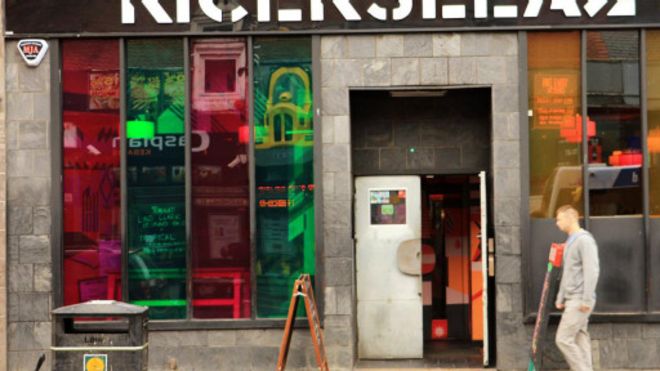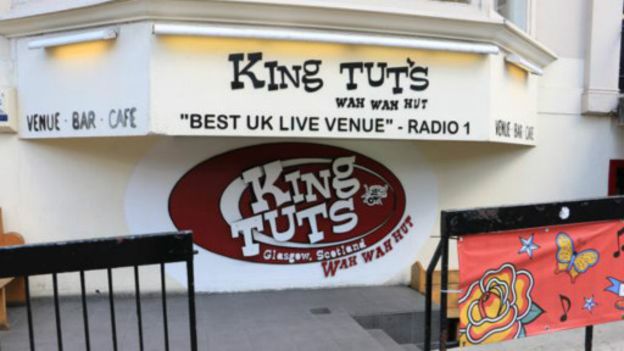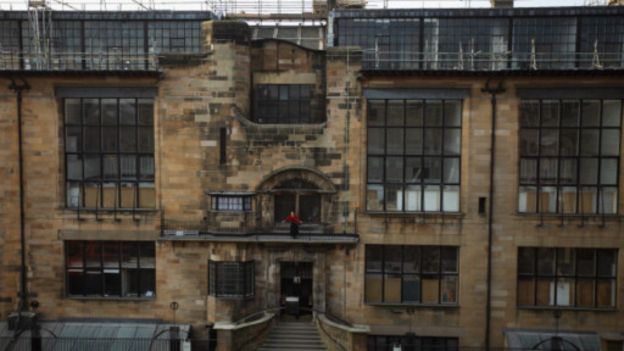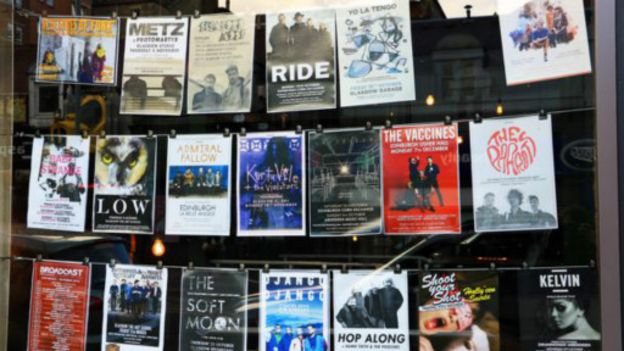摇滚音乐盛行的苏格兰城市
BBC 迈克·麦克伊森(Mike MacEacheran)(2023年12月19日)

苏格兰格拉斯哥的Nice 'n' Sleazy 俱乐部(图片来源:图片来源:Mike MacEacheran)
在格拉斯哥绍齐霍尔大街(Sauchiehall Street)和皮特大街(Pitt Street)交汇处,两个世界在此相遇。西边和北边是格拉斯哥艺术学院附近简陋的学生酒吧和咖啡,这栋建筑一直被视为查尔斯·雷尼·马金托什(Charles Rennie Mackintosh)的杰作,但它在 2014 年惨遭大火破坏之后,现在被脚手架所包围。南边是布里斯伍德广场(Blythswood Square)和圣文森特大街(St Vincent Street)的商业区,充斥着英国乔治王朝时代的富丽堂皇和傲慢。
但格拉斯哥内城街道这种纽约曼哈顿风格的严密布局却比其建筑更胜一筹。它是苏格兰摇滚乐和独立音乐的发祥地。
看看这些例证:格拉斯哥艺术学院的学生会成为乐队们的补给站,这些乐队就包括摇滚乐团体弗朗兹·费迪南乐队 (Franz Ferdinand)、独立流行乐队贝尔和塞巴斯蒂安 (Belle and Sebastian) 以及另类摇滚团体青春歌迷俱乐部 (Teenage Fanclub)。Nice 'n' Sleazy 俱乐部同样值得一提,那里的摇滚乐队有:雪地巡游者(Snow Patrol)、魔怪(Mogwai)和凡士林(The Vaselines)。

格拉斯哥市中心,不同的世界在此相遇。
还有图坦卡蒙王的哇哇小屋(King Tut’s Wah Wah Hut),它是绿洲乐队(Oasis)首演后的签约地,这里几乎见证了每个苏格兰乐队的音乐排行榜进军之路,从崔维斯合唱团(Travis)到比菲·克利罗乐队(Biffy Clyro),莫不如此。这里的墙壁上、颜色各异的门后乃至地板的嘎吱声中,都洋溢着音乐史上的脉动。
格拉斯哥音乐城市之旅的菲奥娜·谢泼德(Fiona Shepherd)表示,“格拉斯哥在世界音乐舞台的成功建立在深深植根于此的音乐文化基础之上。”她于今年 8 月推出了这座城市新的步行之旅,巡游格拉斯哥著名的演出场地、酒吧和俱乐部。“我们是一座港口城市,港口是我们的工业化经济动力,因此我们也一直有引进和输出音乐的传统。格拉斯哥人热爱乡村音乐、灵魂音乐和布鲁斯;这种传统深植于此。来自爱尔兰的民间音乐也在不断融入其中。”
但在世界音乐舞台上,格拉斯哥发挥的作用还只是伦敦或者纽约的十分之一。也许你会纠结这个徒步之旅早就该有,但实际上,早在 2008 年,这座苏格兰城市就已被联合国教科文组织授予“音乐之城”的称号,它是英国唯一一座享此殊荣的城市。(即使是一直自我标榜为世界音乐之都的美国德克萨斯州的奥斯汀,也没有得到联合国教科文组织的命名)

苏格兰每个乐队都是从这条格拉斯哥街道向音乐排行榜发起冲击,从崔维斯合唱团(Travis)到比菲·克利罗乐队(Biffy Clyro),莫不如此。(图片来源:Mike MacEacheran)
Killermont 大街皇家音乐厅飘出阿兹特克·卡梅拉(Aztec Camera)的罗迪·弗雷姆(Roddy Frame)的颂歌,穿越已故的阿波罗,格拉斯哥乐队 AC/DC 在此录制了其首张现场专辑,CCA、02 ABC、Broadcast、Box、Nice ’n’ Sleazy 和 King Tut’s 等乐队都曾在此留下足迹,也让这里成为某些英国最受欢迎乐队音乐之旅的必由之地。
谢泼德说:“你绝不要低估阴暗、破旧、老式的摇滚音乐厅。”她也是苏格兰音乐评论家。“这些地方虽然面积不大,但却能在给人私密感的同时,让人觉得足够重要。它们不仅向我们诉说着音乐风气的由来,更重要的是,也告诉我们音乐的未来走向。”
即使对局外人而言,格拉斯哥看起来也像是个摇滚明星、酒吧歌手、街头艺人和卖艺者的家园。几乎每走过一个街区,都会经过一个现场音乐表演场地或俱乐部;即使在阴冷、乌云密布的白天,格拉斯哥的摇滚乐依然大行其道。
大行其道并不意味着它们不受待见:这种气氛的合作本质就充满自助精神和乐观进取的态度。格拉斯哥是全英国音乐生最为集中的地方,出自格拉斯哥凯尔文学院的 Electric Honey 唱片公司是全球最为成功的学生会唱片公司:它曾发行贝尔和塞巴斯蒂安乐队 1996 年处女专辑以及苏格兰摇滚大腕 Biffy Clyro 乐队和格拉斯哥 Snow Patrol乐队的唱片。

在格拉斯哥艺术学院诞生的乐队包括弗朗兹·费迪南乐队(Franz Ferdinand)贝尔和塞巴斯蒂安(Belle and Sebastian)和青春歌迷俱乐部 (Teenage Fanclub)
乔·麦克阿林登(Joe McAlinden)说:“格拉斯哥是座小城,因此,很容易就能认识其他音乐家和乐队。”他是九十年代苏格兰吉他乐队 Superstar 的前成员,目前是歌手兼歌曲作家,以艺名绰号林登(Linden)演出。“伴随着我们的成长,这里的音乐气氛也日益浓厚,原始尖叫乐队(Primal Scream)和粉蜡笔乐队( The Pastels)的四处演出我们并不太介意。实际上,他们鼓励我们参与其中——我们要支持自己热爱的乐队,某些情况下,我们也在与他们一起演出。”
某种程度上,所有这种相互尊重可追溯到 1979 年 唱片公司 Postcard Records 的组建,它成为 Josef K、Aztec Camera 和 Edwyn Collins’ Orange Juice 等艺术歌曲组合的传播媒介。两年前,市议会特别宣布禁止朋克音乐会,更具体地说,是一股后朋克风正在反弹。随之而来的是 Johnny and the Self-Abusers 乐队的诞生,其演变成 Simple Minds 乐队,随后又有 Altered Images, Deacon Blue, Del Amitri, Texas, Primal Scream 等乐队层出不穷。
青春歌迷俱乐部鼓手弗兰西斯·麦克唐纳(Francis McDonald)说:“我想,风水会轮流转,老牌乐队影响着新一代,即使把他们带到格拉斯哥也是如此。”他也是独唱艺人和两家格拉斯哥乐队 Camera Obscura 和 The Vaselines 的经理。“如果你喜欢格拉斯哥的乐队,你可能会选择来这里学习、交友或工作,新鲜血液的注入意味着总是会有新乐队在诞生。格拉斯哥孕育着一种特别的气氛,能让音乐家不必站得太高。当然也会有这样的暗示:‘如果他们都能组建乐队,我也能啊……’”

现场演出海报仅仅是格拉斯哥千变万化的音乐气氛的一个写照。(图片来源:Mike MacEacheran)
让这种气氛接地气的另一个原因是,大多数乐队很少“升级”,离开格拉斯哥寻求一举成名。贝尔和塞巴斯蒂安乐队继续在格拉斯哥西区居住,魔怪乐队也常常在 Nice ’n’ Sleazy 出现,独立乐队 The Pastels 主唱史蒂文·麦克罗比(Steven McRobbie)也与人合伙创办单轨唱片行(Monorail Music)。
格拉斯哥人以玩世不恭而声名在外,这也帮助避免了各乐队受到升级想法的感染。如果你有机会去巴罗兰德舞厅(Barrowland Ballroom)这座城市最有故事的去处一游,也会留下这种不可动摇的印象。巴罗兰德舞厅破烂不堪,目光所及是剥落的油漆,嘎吱作响的、凹凸不平的地板,连卫生间也破破烂烂,这里不是娱乐场所,而是音乐的殿堂,也是曾经的舞厅,它有着顽强的生命力。
周五或周六晚上,你能见识它的活力十足,舞池中充满饮酒狂欢者的喧嚣,这不禁提醒人们,格拉斯哥大众是怎样帮助一个乐队挖掘其全部潜能,无论好与坏,只要他们置身舞台,灯光闪烁之处,万众瞩目,一切就皆有可能。
因为这是格拉斯哥,孕育摇滚乐明星的摇篮。
(责编:友义)
The Scottish city where rock ’n’ roll reigns
By Mike MacEacheran,19 December 2024
At the intersection of Glasgow’s Sauchiehall and Pitt Streets, two worlds meet. To the north and west are the rudimentary student bars and cafes near the Glasgow School of Art, a building long considered Charles Rennie Mackintosh’s masterpiece, though now framed by scaffolding after a ravaging 2014 fire. To the south is the mercantile quarter of Blythswood Square and St Vincent Street, all Georgian grandeur and hubristic wealth.
But this tight Manhattan-style grid of inner city streets is much more than its architecture. It is ground zero for Scottish rock ’n’ roll and indie music.
Dream bag, heavenly heels, the perfect dress – discover your shopping heaven in London. Find something amazing for yourself or that someone special. This is the city the world’s top designers call home, where you too can create your very own costume drama. Play the video to find out how London has it all.
Click here to find out more
Consider the evidence: the Union at the Glasgow School of Art was a staging post for bands including rock group Franz Ferdinand, indie pop band Belle and Sebastian and alt-rock group Teenage Fanclub. The same can be said of Nice ’n’ Sleazy, where members of rock bands Snow Patrol, Mogwai and The Vaselines – which was once described as Nirvana rocker Kurt Cobain’s favourite group in the whole world – found their feet.
Or consider King Tut’s Wah Wah Hut, the place where Oasis were signed after their first gig, and from where every Scottish band, from Travis or Biffy Clyro, has begun their assault on the charts. Here music history lives and breathes in the walls, behind the painted doors, in the creak of the floorboards.
"Glasgow’s success on the global music stage has been built on our deep-rooted music culture,” said Fiona Shepherd of Glasgow Music City Tours, who launched the city’s new walking tour of prominent venues, pubs and clubs in August. “We’re a port city – and that drove our industrialised economy – so we have a history of importing and exporting our music. People here love country, soul and the blues; that runs deep. And there was a constant influx of folk music from Ireland.”
Despite its role in the global music scene, Glasgow is just a tenth the size of London or New York. In fact, given that the Scottish city was named the UK’s only Unesco City of Music in 2008, you could argue that the walking tours are overdue. (Even Austin, Texas – which brands itself as the live music capital of the world – doesn’t have Unesco status).
The tour winds from the Royal Concert Hall on Killermont Street, eulogised in song by Aztec Camera’s Roddy Frame, past the now defunct Apollo, where Glasgow-born band AC/DC recorded their first live album, to venues including the CCA, 02 ABC, Broadcast, Box, Nice ’n’ Sleazy and King Tut’s – making it a wander through a musical landscape responsible for some of the UK’s favourite bands.
“You should never underestimate the appeal of a dilapidated, scuzzy, old-fashioned rock ’n’ roll venue,” said Shepherd, who is also The Scotsman’s music critic. “These are places small enough to feel intimate, but big enough to feel important. They help tell the story of where our music scene has come from – and more importantly, where it is going.”
Even to an outsider, Glasgow appears like a community of rock stars, pub singers, buskers and performers. It’s hard to walk more than a block without passing a live music venue or club; even during daylight, under a bleak, thundercloud sky, Glasgow maintains its rock ’n’ roll swagger.
But swagger doesn’t mean unwelcoming: the scene’s collaborative nature is steeped in DIY mythology and a can-do attitude. The city has the highest concentration of music students in the UK, and the Electric Honey record label, run out of Glasgow Kelvin College, is the most successful student union record label in the world: it released Belle and Sebastian’s 1996 debut album as well as records from Biffy Clyro, Scotland’s reigning rock band, and Glasgow-based Snow Patrol.
“It’s a small city so it’s easier to get to know other musicians and bands than elsewhere,” said Joe McAlinden, an ex-member of 1990s Scottish guitar band Superstar and now a singer-songwriter performing under the moniker Linden. “When we were growing up, the scene was most welcoming. Primal Scream and The Pastels didn’t mind us lot hanging around. In fact, they encouraged us to get involved – we got to support the bands we loved and in some cases got to play with them, too.”
To some extent, all this mutual respect can be traced back to the 1979 formation of Postcard Records, the music label that became a vehicle for the arty melodies of groups like Josef K, Aztec Camera and Edwyn Collins’ Orange Juice. Two years earlier, the city council had banned punk – punk concerts, specifically – and a post-punk, new wave backlash was on the way. What followed was the birth of Johnny and the Self-Abusers, who morphed into Simple Minds, then came Altered Images, Deacon Blue, Del Amitri, Texas, Primal Scream… the list goes on.
“I think the wheel keeps turning – established bands influence the next generation, even pulling them into the city,” said Francis McDonald, Teenage Fanclub’s drummer, a solo artist and manager of Glaswegian bands Camera Obscura and The Vaselines. “If you like bands from the city, you might choose to go and study, socialise or work there – and that fresh blood means new bands start up all the time. Glasgow fosters a special kind of grounding that ensures musicians don’t get to stand on too high a pedestal. There is definitely a hint of, ‘If they can form a band, I can, too…’”
What also the keeps the scene grounded is that most bands rarely “trade up”, moving away from the city for a greater shot at stardom. Belle and Sebastian continue to live in the city’s West End, Mogwai can be spotted drinking in Nice ’n’ Sleazy, and Steven McRobbie, frontman of indie luminaries The Pastels, co-owns Monorail Music in Kings Court.
But to see it in full swing on a Friday or Saturday night, when the dance floor turns into a raucous bear pit of revellers, is to be reminded of how a Glasgow crowd can help a band realise their full potential, reminding them – for better or for worse – that when they are on stage, with the lights dimmed and all eyes on them, anything is possible.
Because in Glasgow, that’s how rock ’n’ roll stars are made.